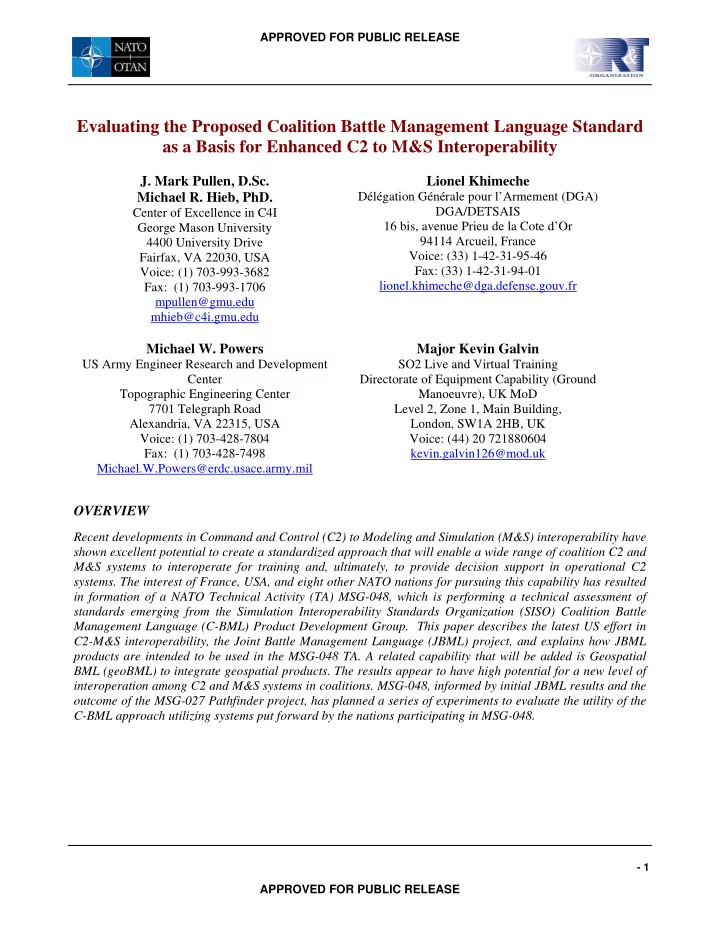

APPROVED FOR PUBLIC RELEASE Evaluating the Proposed Coalition Battle Management Language Standard as a Basis for Enhanced C2 to M&S Interoperability J. Mark Pullen, D.Sc. Lionel Khimeche Délégation Générale pour l’Armement (DGA) Michael R. Hieb, PhD. DGA/DETSAIS Center of Excellence in C4I 16 bis, avenue Prieu de la Cote d’Or George Mason University 94114 Arcueil, France 4400 University Drive Voice: (33) 1-42-31-95-46 Fairfax, VA 22030, USA Fax: (33) 1-42-31-94-01 Voice: (1) 703-993-3682 lionel.khimeche@dga.defense.gouv.fr Fax: (1) 703-993-1706 mpullen@gmu.edu mhieb@c4i.gmu.edu Michael W. Powers Major Kevin Galvin US Army Engineer Research and Development SO2 Live and Virtual Training Center Directorate of Equipment Capability (Ground Topographic Engineering Center Manoeuvre), UK MoD 7701 Telegraph Road Level 2, Zone 1, Main Building, Alexandria, VA 22315, USA London, SW1A 2HB, UK Voice: (1) 703-428-7804 Voice: (44) 20 721880604 kevin.galvin126@mod.uk Fax: (1) 703-428-7498 Michael.W.Powers@erdc.usace.army.mil OVERVIEW Recent developments in Command and Control (C2) to Modeling and Simulation (M&S) interoperability have shown excellent potential to create a standardized approach that will enable a wide range of coalition C2 and M&S systems to interoperate for training and, ultimately, to provide decision support in operational C2 systems. The interest of France, USA, and eight other NATO nations for pursuing this capability has resulted in formation of a NATO Technical Activity (TA) MSG-048, which is performing a technical assessment of standards emerging from the Simulation Interoperability Standards Organization (SISO) Coalition Battle Management Language (C-BML) Product Development Group. This paper describes the latest US effort in C2-M&S interoperability, the Joint Battle Management Language (JBML) project, and explains how JBML products are intended to be used in the MSG-048 TA. A related capability that will be added is Geospatial BML (geoBML) to integrate geospatial products. The results appear to have high potential for a new level of interoperation among C2 and M&S systems in coalitions. MSG-048, informed by initial JBML results and the outcome of the MSG-027 Pathfinder project, has planned a series of experiments to evaluate the utility of the C-BML approach utilizing systems put forward by the nations participating in MSG-048. - 1 APPROVED FOR PUBLIC RELEASE
Evaluating the Proposed C-BML Standard for Enhanced C2 to M&S Interoperability 1.0 Introduction A Battle Management Language (BML) is defined as an unambiguous language intended to provide for both command and control of simulated and live forces conducting military operations and situational awareness and a shared, common operational picture. Recent developments in us of BML for Command and Control (C2) to Modeling and Simulation (M&S) interoperability have shown excellent potential to create a standardized approach that will enable a wide range of coalition C2 and M&S systems to interoperate for training and, ultimately, to provide decision support in operational C2 systems [1-8]. In October of 2004 France and the US presented demonstrations to the North Atlantic Treaty Organization (NATO) M&S Working Group showing how a BML and JC3IEDM can enable interoperation of command and control (C2) and simulation systems of multiple nations. As a result, an Exploratory Team (ET-016) was formed to investigate the feasibility of a Coalition BML (C-BML). The Exploratory Team developed a strong rationale for international collaboration in evaluating the potential of C2-Simulation interoperation technology. The Simulation Interoperability Standards Organization (SISO), an international organization with industry, academia and government all represented, is developing the Coalition Battle Management Language (C- BML) to provide a basis for C2-Simulation interoperability [9]. ET-016 concluded that a NATO-based effort could be most effective by providing a separate experimental validation of the potential benefits of C-BML. This recommendation was highlighted demonstration of interoperation between C2 and M&S systems of France and the US, and reported in [10]. In this paper, we continue describing advances in BML, based on US contributions to the C-BML effort and also on the NATO M&S Group’s Technical Activity, MSG-048, that is applying the results in experimental validation of C-BML. This paper draws heavily on publications by its authors in other forums, particularly references [19,20], in order to present the work of JBML, MSG-048, and the emerging SISO C-BML standard to the larger NATO M&S community. 2.0 Background The Joint Battle Management Language (JBML) activity is contributing significant efforts from the US in support of SISO’s C-BML Product Development Group (PDG). JBML is not just “yet another BML” but is intended to become the first contribution to a growing family of standards. While JBML has been developed to solve real requirements of the warfighter in support of exercises and experimentation, it also supports the C-BML standard development process. The project also is intended to support international collaboration within SISO as well as within the MSG-048 TA. To meet all of these goals, JBML has been laid out as a multiphase project which now has reach the end of its Phase 1, which in turn feeds Phase 1 of SISO-C-BML. 3.0 The JBML Project The goal of this project is to develop a standard Battle Management Language applicable to US Service and Joint Users as an input to the SISO C-BML process. The need to interface Command and Control (C2) systems with Modeling and Simulation (M&S) systems has long been established. However, in the absence of DoD-wide standards for C2-to-M&S interoperability, almost every simulation has a unique C2 interface. The BML effort addresses this need by basing its semantics on the international Multinational Interoperability Program (MIP) data standards. Of particular interest for JBML is that the MIP provides a common, system- independent C2 vocabulary for data interchange. 3.1 History BML was never seen as an exclusively technical solution; it is an approach to supporting the operational - 2 APPROVED FOR PUBLIC RELEASE
Recommend
More recommend